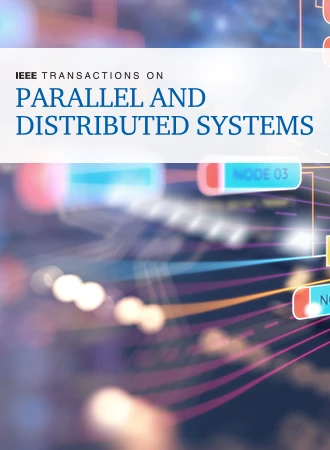High Performance Householder QR Factorization on Emerging GPU Architectures Using Tensor Cores
IF 5.6
2区 计算机科学
Q1 COMPUTER SCIENCE, THEORY & METHODS
IEEE Transactions on Parallel and Distributed Systems
Pub Date : 2024-12-25
DOI:10.1109/TPDS.2024.3522776
引用次数: 0
Abstract
Since 2017, NVIDIA GPUs have been equipped with specialized units known as Tensor Cores, which demonstrate remarkable efficiency in processing matrix multiplications (GEMMs). Beyond GEMMs, researchers have explored the potential applications of Tensor Cores in matrix factorization, such as QR factorization. However, the inside GEMMs in QR factorization are typically tall and skinny. Compared to compute-bound square GEMMs, these tall and skinny GEMMs are memory bound, leading to suboptimal performance on Tensor Cores. To solve this problem, we indicate the recursive QR factorization can convert the tall and skinny GEMMs to relatively square and large GEMMs, resulting in better performance on Tensor Cores. Besides, we extend the FP16 Tensor-Cores-based QR factorization to accommodate FP32 and FP64 on FP16 and INT8 Tensor Cores, respectively. Additionally, to address the issue of orthogonality loss in the preceding Tensor Cores-based QR factorization, we transition from the Gram-Schmidt to the Householder algorithm while preserving high performance. According to our experimental evaluation conducted on NVIDIA's A100 and GeForce RTX 3090 GPU, the precision levels of FP64, FP32, and FP16 are up to 6.22x, 8.67x, and 4.03x faster, respectively, than the current state-of-the-art implementations.基于张量核的新型GPU架构的高性能户型QR分解
自2017年以来,NVIDIA gpu配备了称为张量核心(Tensor Cores)的专用单元,在处理矩阵乘法(gemm)方面表现出卓越的效率。除了gemm,研究人员还探索了张量核在矩阵分解中的潜在应用,例如QR分解。然而,QR分解中的内部gem通常又高又瘦。与计算绑定的方形gem相比,这些又高又瘦的gem是内存绑定的,导致在张量核心上的性能不佳。为了解决这个问题,我们指出递归QR分解可以将高而瘦的gemm转换为相对方形和较大的gemm,从而在张量核上获得更好的性能。此外,我们扩展了基于FP16张量核的QR分解,以适应FP16和INT8张量核上的FP32和FP64。此外,为了解决之前基于张量核的QR分解中的正交性损失问题,我们从Gram-Schmidt算法过渡到Householder算法,同时保持高性能。根据我们对NVIDIA A100和GeForce RTX 3090 GPU进行的实验评估,FP64、FP32和FP16的精度水平分别比目前最先进的实现快6.22倍、8.67倍和4.03倍。
本文章由计算机程序翻译,如有差异,请以英文原文为准。
求助全文
约1分钟内获得全文
求助全文
来源期刊

IEEE Transactions on Parallel and Distributed Systems
工程技术-工程:电子与电气
CiteScore
11.00
自引率
9.40%
发文量
281
审稿时长
5.6 months
期刊介绍:
IEEE Transactions on Parallel and Distributed Systems (TPDS) is published monthly. It publishes a range of papers, comments on previously published papers, and survey articles that deal with the parallel and distributed systems research areas of current importance to our readers. Particular areas of interest include, but are not limited to:
a) Parallel and distributed algorithms, focusing on topics such as: models of computation; numerical, combinatorial, and data-intensive parallel algorithms, scalability of algorithms and data structures for parallel and distributed systems, communication and synchronization protocols, network algorithms, scheduling, and load balancing.
b) Applications of parallel and distributed computing, including computational and data-enabled science and engineering, big data applications, parallel crowd sourcing, large-scale social network analysis, management of big data, cloud and grid computing, scientific and biomedical applications, mobile computing, and cyber-physical systems.
c) Parallel and distributed architectures, including architectures for instruction-level and thread-level parallelism; design, analysis, implementation, fault resilience and performance measurements of multiple-processor systems; multicore processors, heterogeneous many-core systems; petascale and exascale systems designs; novel big data architectures; special purpose architectures, including graphics processors, signal processors, network processors, media accelerators, and other special purpose processors and accelerators; impact of technology on architecture; network and interconnect architectures; parallel I/O and storage systems; architecture of the memory hierarchy; power-efficient and green computing architectures; dependable architectures; and performance modeling and evaluation.
d) Parallel and distributed software, including parallel and multicore programming languages and compilers, runtime systems, operating systems, Internet computing and web services, resource management including green computing, middleware for grids, clouds, and data centers, libraries, performance modeling and evaluation, parallel programming paradigms, and programming environments and tools.
 求助内容:
求助内容: 应助结果提醒方式:
应助结果提醒方式:


